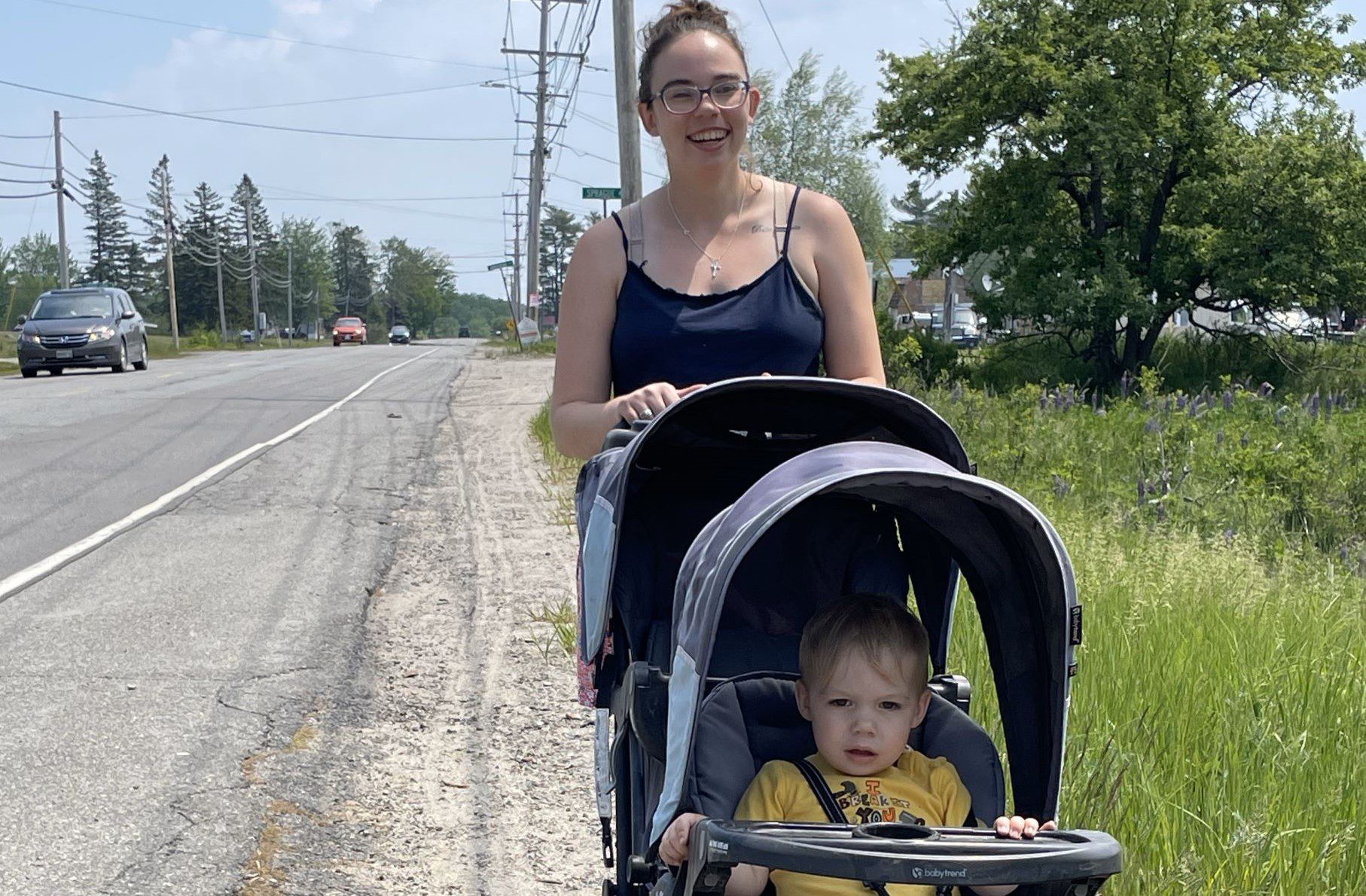While Down East tourists celebrated the mercury pushing 90 degrees this week, the soaring temperatures were unwelcome and potentially dangerous for one young mom, Alexa Dionne, who needed diapers Wednesday for her 2-year-old son.
With Dionne’s husband Luke at work and the family “between vehicles,” she had no choice but to push her toddler in a stroller 2½ miles along the steamy pavement of busy Route 1 in Machias.
What would have been a five-minute drive took Dionne an exhausting, harrowing two hours.
“The shoulders of the road on both sides are crap and unsafe for walking families, let alone ones with strollers,” Dionne said. “I had to walk practically in the road, getting weird looks from drivers.”
The family is only one of many who struggle with transportation in Washington County, which stretches 122 miles from its farthest points and is larger than the state of Delaware.
Despite the yawning geography and roughly 32,000 year-round residents, there isn’t a comprehensive public transportation system — and only a single private taxi company for the entire county — located in Calais. If you’re lucky, Gary Marrs and his wife Denise of Gary’s Taxi both might be driving. Then there would be two.
“I could retire but I just keep doing it because people around Calais kind of depend on me,” said Marrs, who’s been running Gary’s Taxi for almost two decades.
Although Marrs will drive people outside Calais, the fare is often out of reach, at least for low-income people in this county, where the poverty rate hovers near 20 percent.
A round-trip to Machias in Gary’s Taxi costs $100. The meter hits $250 for a trip to Bangor, where many county residents have to travel for special medical needs, a major hospital, a commercial airport or even a movie and dinner date.
Asked if there’s a transportation gap, Machias Town Manager Bill Kitchen scoffed, saying it’s not a gap, it’s a chasm. He said the county has neither micro-transportation, such as county-wide taxi or public bus service, or macro transportation like rail or air service. He added that even getting to those services is nearly impossible without a vehicle.
“Bangor and Portland are your launching points, it’s not here,” Kitchen said. “You have to get to your jumping-off point before you can go anywhere. It’s crazy.”
Washington County Commissioner Chris Gardner agreed, though he believes transportation is merely a symptom of a larger problem that must be solved first — the county simply needs more people, more businesses to create a critical mass that would justify more reliable transportation services
According to United States Census Bureau 2022 statistics, Washington County has only 12 people per square mile. Larger municipalities, such as Machias and Calais, are more densely populated with around 2,000 and 3,000 residents, respectively, and there’s been an influx of new residents since COVID. Still, it remains one of the smallest and most rural counties in the state.
Gardner said the transportation challenges Washington County faces are no different from those of other rural communities. That comparison does little to help the county’s low-income residents without personal vehicles, who struggle daily to get to school, daycare, medical appointments, the grocery store and their jobs — or, for many, like the Dionnes, two jobs in one day.
The Dionnes, who also have two school-age daughters, recently moved to Washington County from Presque Isle to attend college, Luke in Calais for auto mechanics and Alexa in Machias for environmental biology, but they have become discouraged trying to get around without a reliable vehicle. A single trip between the two campuses cost them $60 round-trip in their 2001 Dodge Ram truck before it became too expensive to keep repairing. For now they have to walk, a reality they say is frightening and daunting.
For families already on the margins, the additional stress of trying to get to a job — and keep it — takes a toll on parents and their children, said Ellen Farnsworth, a family visitor for Maine Families of Washington County, providing support for pregnant and parenting families. Farnsworth recalled one particularly dire situation where two moms shared a bike, trading it back and forth to get to work, and hitched on a wagon to carry their kids. She said such precarious arrangements, or relying on the kindness of others, are not sustainable.
“People may get a job and try to count on a co-worker to transport them, but people are not always as reliable as you need them to be,” Farnsworth said. “I would say, nine times out of ten, after a few months, they usually lose that job because they’ve had to miss work.”
Tragically, not all county residents who must travel by foot, bicycle or other alternative means of transportation arrive at their destinations safely.
The most recent data shows that 10-12 percent of traffic fatalities in Maine are pedestrians and cyclists, according to Jean Sideris, executive director for the Bicycle Coalition of Maine. Typically, over each of the last five years statewide, 16 pedestrians and two bicyclists lost their lives.
Washington County mirrors those statistics with the Maine Department of Transportation reporting that between 2016 and 2020, there were seven pedestrian crashes, where three people died and four more suffered injuries. One cyclist also died and another five were seriously injured.
“Severe brain injuries are also a very common result of these types of crashes and that’s lifelong trauma that you never really get over,” Sideris said. “I think we can get caught up in the statistics, but those are people with families that are irreparably, terribly affected.”
Although the county lacks a comprehensive solution, several public and philanthropic agencies, as well as a handful of private businesses, are working to at least partially fill the gaps with a patchwork system that offers transportation options for some, although certainly not all.
On the private front, there are Gary’s Taxi, L&L Transport (which serves only medically insured riders), and most notably, West’s Bus Service, which serves any Down Easter from Calais to Machias, Ellsworth, Bangor and “points in between,” seven days a week, according to the website.
Fares range from $16 to $42 and there is only one pickup and return time for each town on the route, with flag stops along the way. Those would-be riders are instructed to “please make yourself visible near the curb. Place your luggage beside the road and wave the bus to a stop.”
David Ginn of East Machias, a former commercial truck driver, said none of those are viable options for him. Ginn has to travel to and from his home several days a week for his job at McDonald’s in Machias with a schedule that doesn’t line up with West’s Bus Service, flag or no flag.
His solution? A lime-green, lithium battery-powered trike. The Class 2 vehicle is legal for the road and only cost Ginn roughly $3,000. He said it’s also dirt cheap to operate at about 14 cents per charge for about 85 miles of travel between boosts.
“I really like riding it. I don’t even have to pedal if I don’t want to,” Ginn said. “I’ll be riding along and the next thing I know, I’m passing people!”

Ginn knows using the trike in winter will be less pleasant and more dangerous. He said even now, when the roads are ice-free, some car drivers are leery when they encounter Ginn, and vice versa, especially when he goes really low-tech and travels with his skateboard.
Some “micro-mobilizers,” as transportation safety advocates call them, play it safer whenever possible to get to work and other appointments, using off-road routes such as the Down East Sunrise Trail, an 87-mile, multi use corridor running along old rail lines from Ellsworth to Calais, where work commuters on ATVs are sometimes seen with a lunch box strapped behind.
But electric bikes and ATVs are way beyond the means of many who often have to scrape just to find money for a good pair of walking shoes.
Among the myriad county not-for-profits trying to help is Down East Community Partners (DECP), which provides rides in Washington and Hancock counties, primarily for medically insured or grant-qualifying commuters such as DHS and MaineCare recipients, cancer patients and people receiving treatment for substance disorders. DECP will drive those in the general public on one of their vans for a small fee.
But the so-called “public bus” option is only an option when a rider is going where the DECP vans are going. Those routes vary daily and there aren’t always enough vans or drivers to accommodate everyone, according to Tiffany Bohacik, operations manager for DECP. She said trips are determined and prioritized according to the needs of medical patients.
“We certainly do our best to accommodate everyone, but unfortunately we have a shortage of drivers right now and our medical appointments come first,” Bohacik said.
Other resources are available for qualifying residents, including Helping Hands Garage, a car financing program run by DECP, working with local banks; Family Futures Downeast, a two-generation college program for parents and their children that helps ease transportation barriers; and the Hope Fund, providing grants of up to $1,000 to assist with vehicle repairs.
The Hope Fund is supported mostly with donations and is administered by the Community Caring Collaborative (CCC), a county partnership of more than 45 agencies, along with nonprofits and community members working to improve the lives of vulnerable individuals and families. According to the CCC executive director, Charley-Martin Berry, over the last 10 years the Hope Fund has awarded roughly $700,000 in what she called rare, “flexible” transportation support.
“It’s hard to find a resource for fixing a car. That’s not something the state typically would support like they might with heating or nutrition assistance. Transportation isn’t part of the safety net,” Martin-Berry said.
But a couple of years ago, Martin-Berry said the CCC began envisioning what such a safety net might look like, planning with agencies like the Sunrise County Economic Council (SCEC) and others. The MDOT also began laying the groundwork for improvements with its recently unveiled $3.94 billion three-year transportation plan, with dozens of projects slated for Washington County.
MDOT contracted with the SCEC to help design a transportation plan that might improve road safety and alleviate, if not erase, the county’s transportation divide. Crystal Hitchings, director of community infrastructure and promotion programs for the SCEC, heads the project.
Hitchings will work with the MDOT and municipal leaders, looking at a number of solutions, as well as planning to avoid or mitigate potential safety issues from planned MDOT projects that could bring more traffic Down East. Hitchings said the county needs a plan to make sure residents, motorists, cyclists and pedestrians are safe.
Those also are concerns for Gardner, the county commissioner. But Gardner also sees the bypass as a smart move by MDOT that will improve transportation efficiency and could lead to much-needed economic growth for Washington County. He said the county needs to create new businesses and transportation is key.
“You know what, there aren’t roads built to all those new economies yet,” Gardner said. “Well, if you don’t want to build new roads or expand rail or whatever it may be, to the places where you want these new economies, you can’t have it both ways.”







